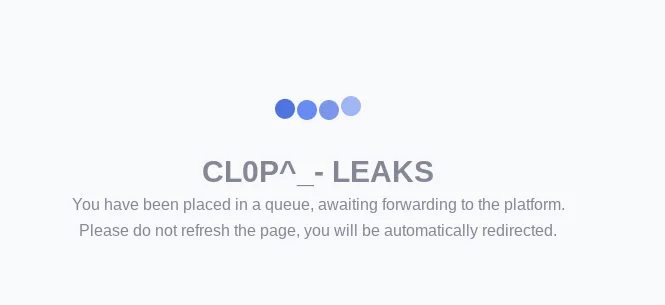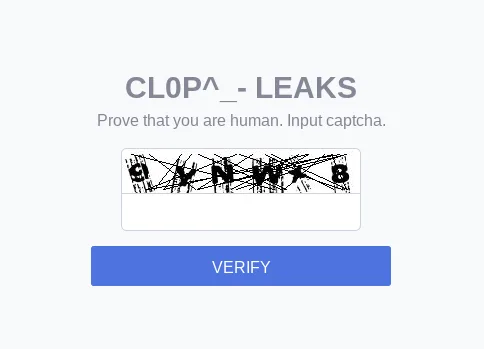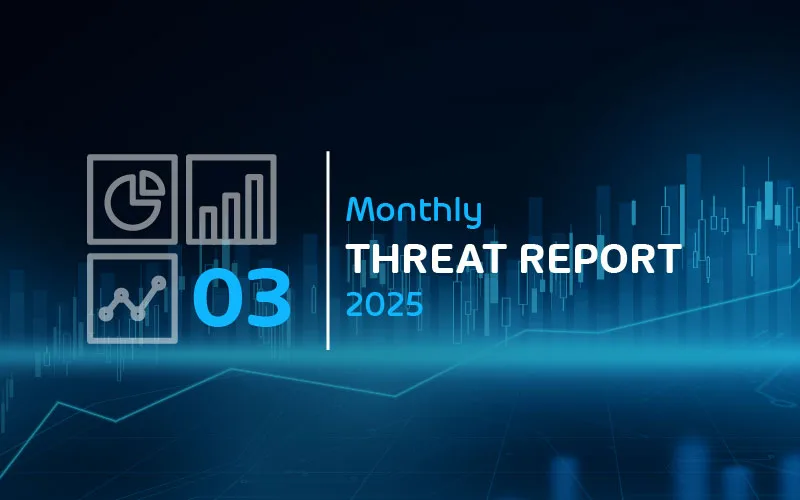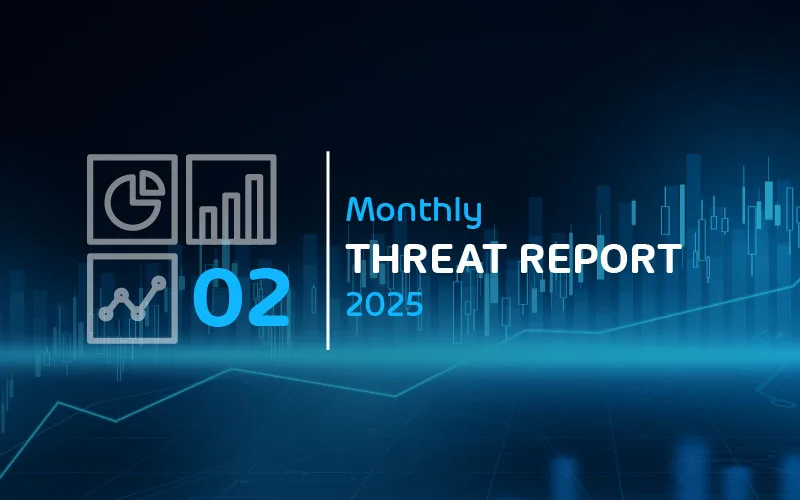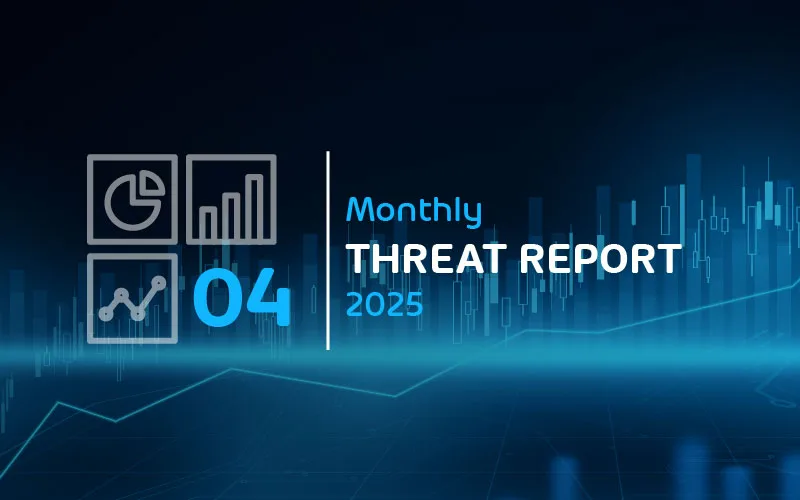

Email Threat Review September 2021
Executive Summary
This month, large scale phishing attacks against two German banking associations (Sparkasse and Volksbanken und Raiffeisenbanken).
Summary
In this installment of our monthly email threat review, we present an overview of the email-based threats observed in September 2021 and compare them to the previous month’s threats.
The report provides insights into:
- Unwanted emails by category
- File types used in attacks
- Industry Email Threat Index
- Attack techniques
- Impersonated company brands and organizations
- Ransomleaks
Unwanted emails by category
The following table shows the distribution of unwanted emails per category.
| Email category | % |
| Rejected | 80.83 |
| Spam | 14.15 |
| Threat | 4.07 |
| AdvThreat | 0.91 |
| Content | 0.03 |
The following time histogram shows the email volume per category per day.

The spike in rejected emails around 2021-09-23 can be attributed to a monthly reoccurring sextortion scam email campaign written in the German language that we observe each month.
Methodology
The listed email categories correspond to the email categories listed in the Email Live Tracking of Hornetsecurity’s Control Panel. So our users are already familiar with them. For others, the categories are:
| Category | Description |
| Spam | These emails are unwanted and are often promotional or fraudulent. The emails are sent simultaneously to a large number of recipients. |
| Content | These emails have an invalid attachment. The administrators define in the Content Control module which attachments are invalid. |
| Threat | These emails contain harmful content, such as malicious attachments or links, or they are sent to commit crimes like phishing. |
| AdvThreat | Advanced Threat Protection has detected a threat in these emails. The emails are used for illegal purposes and involve sophisticated technical means that can only be fended off using advanced dynamic procedures. |
| Rejected | Our email server rejects these emails directly during the SMTP dialog because of external characteristics, such as the sender’s identity, and the emails are not analyzed further. |
File types used in attacks
The following table shows the distribution of file types used in attacks.
| File type (used in malicious emails) | % |
| HTML | 37.2 |
| Archive | 28.8 |
| 11.3 | |
| Excel | 6.4 |
| Disk image files | 4.6 |
| Other | 4.0 |
| Word | 3.7 |
| Executable | 3.5 |
| Powerpoint | 0.2 |
| Script file | 0.2 |
The following time histogram shows the email volume per file type used in attacks per 7 days.

We see the continuation of last month’s observation concerning the increase in HTML file attachments (.htm, .html, etc.) used in attacks. On closer analysis, the growth can be attributed to multiple campaigns using HTML files for phishing by having the phishing website attached directly to the email1 (thus circumventing URL filters). We already report on this technique in our blog.
Industry Email Threat Index
The following table shows our Industry Email Threat Index calculated based on the number of threat emails compared to each industry’s clean emails received (in median).
| Industries | Share of threat in threat and clean emails |
| Manufacturing industry | 6.0 |
| Research industry | 5.7 |
| Media industry | 5.3 |
| Healthcare industry | 5.2 |
| Automotive industry | 5.1 |
| Education industry | 5.1 |
| Transport industry | 5.0 |
| Construction industry | 4.9 |
| Mining industry | 4.9 |
| Retail industry | 4.4 |
The following bar chart visualizes the email-based threat posed to each industry.
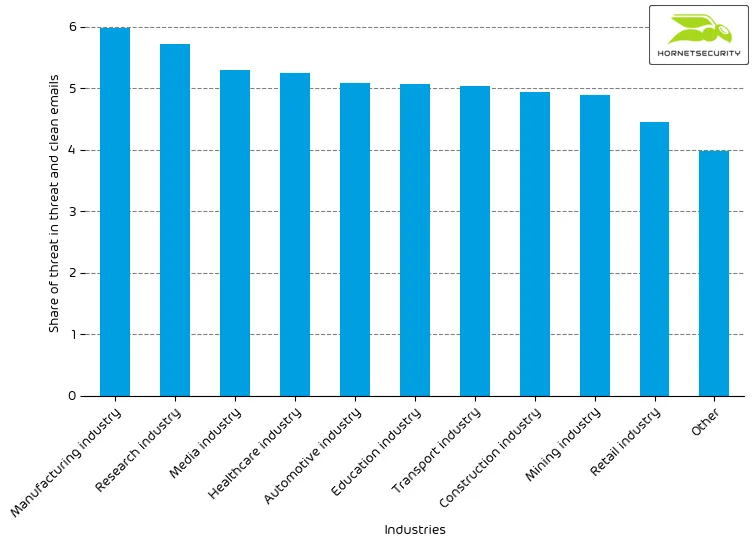
We observe an overall increase in threat emails per clean email received for all industry sectors.
Methodology
Different (sized) organizations receive a different absolute number of emails. Thus, we calculate the percent share of threat emails from each organization’s threat and clean emails to compare organizations. We then calculate the median of these percent values for all organizations within the same industry to form the industry’s final threat score.
Attack techniques
The following table shows the attack techniques used in attacks.
| Attack technique | % |
| Other | 39.0 |
| Phishing | 29.1 |
| Impersonation | 10.3 |
| URL | 10.0 |
| Advance-fee scam | 3.5 |
| Extortion | 3.1 |
| Executable in archive/disk-image | 3.1 |
| Maldoc | 1.9 |
The following time histogram shows the email volume per attack technique used per hour.
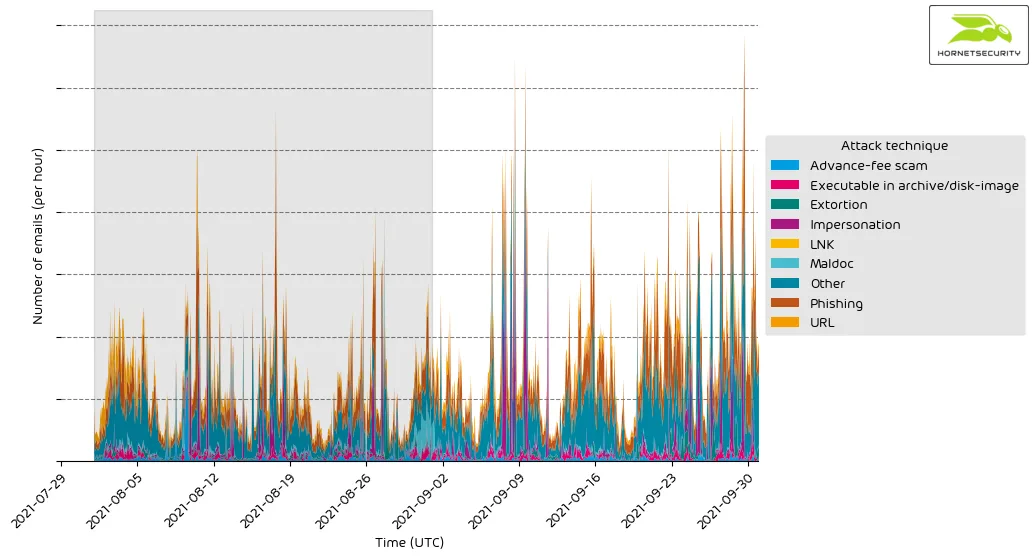
Impersonated company brands and organizations
The following table shows which company brands and organizations our systems detected most in impersonation attacks.
| Impersonated brand or organization | % |
| Sparkasse | 19.7 |
| Volks- und Raiffeisenbank | 15.0 |
| Deutsche Post / DHL | 13.5 |
| DocuSign | 12.5 |
| Other | 11.3 |
| Amazon | 8.9 |
| PayPal | 4.6 |
| 1.9 | |
| Microsoft | 1.7 |
| UPS | 1.3 |
| HSBC | 1.1 |
The following histogram shows the email volume for company brands and organizations detected in impersonation attacks per hour.
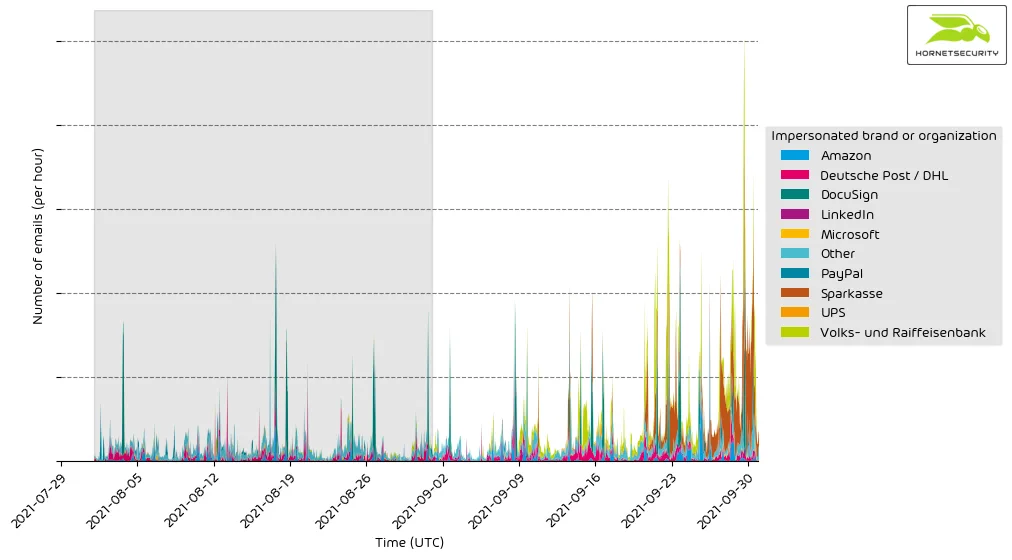
There is a significant increase in campaigns impersonating the German banks Sparkasse and Volks- und Raiffeisenbank. We detected multiple different phishing email campaigns targeting these two German banks.
One example phishing email impersonating Sparkasse:
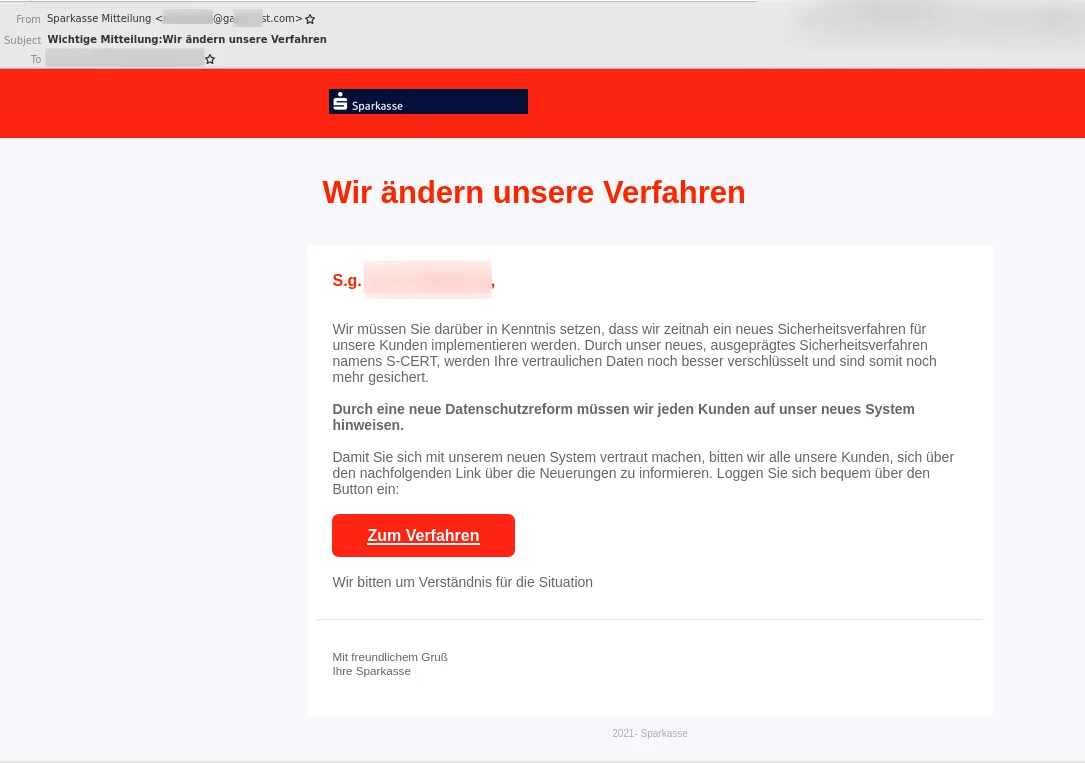
One example phishing email impersonating Volks- und Raiffeisenbank:
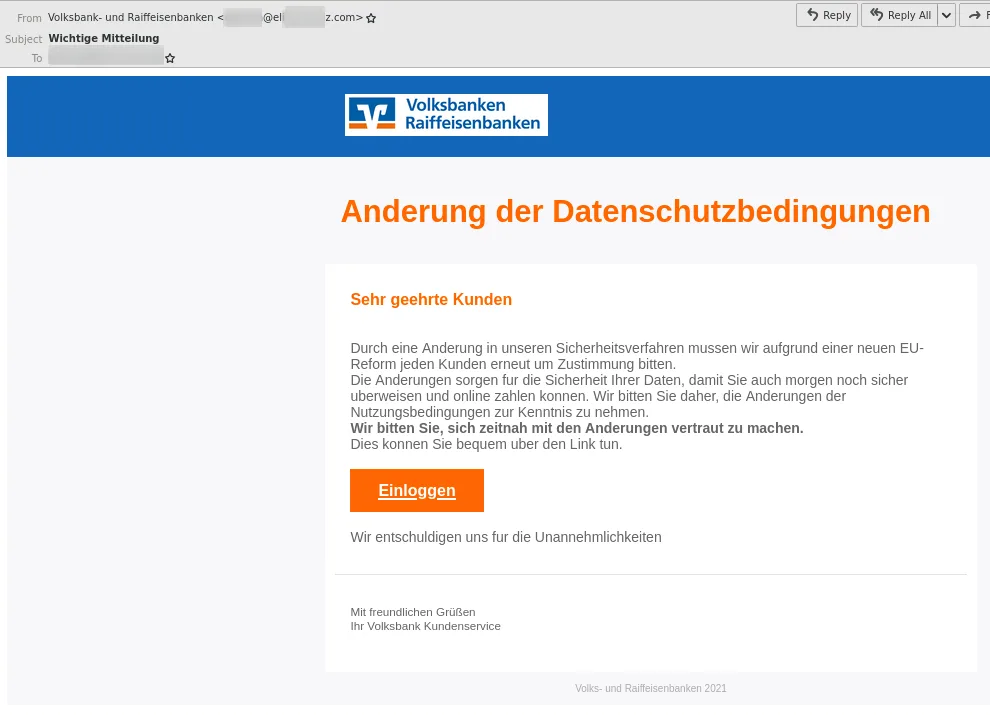
In all variants of the large-scale campaigns, the banks allegedly changed their (security) processes and the user needs to log in to confirm the change to retain access to their bank account.
Ransomleaks
Threat actors continue to leak data stolen from ransomware victims to pressure them to pay for decrypting the files and not publishing sensible data. We observed the following number of leaks on ransomware leak sites:
| Leak site | Number of victim data leaks |
| Conti | 40 |
| LockBit 2.0 | 34 |
| Pysa | 15 |
| Everest | 8 |
| Vice Society | 7 |
| Hive | 5 |
| REvil | 5 |
| RansomEXX | 3 |
| Lorenz | 1 |
The following bar chart visualizes the number of victim data leaks per leak site.
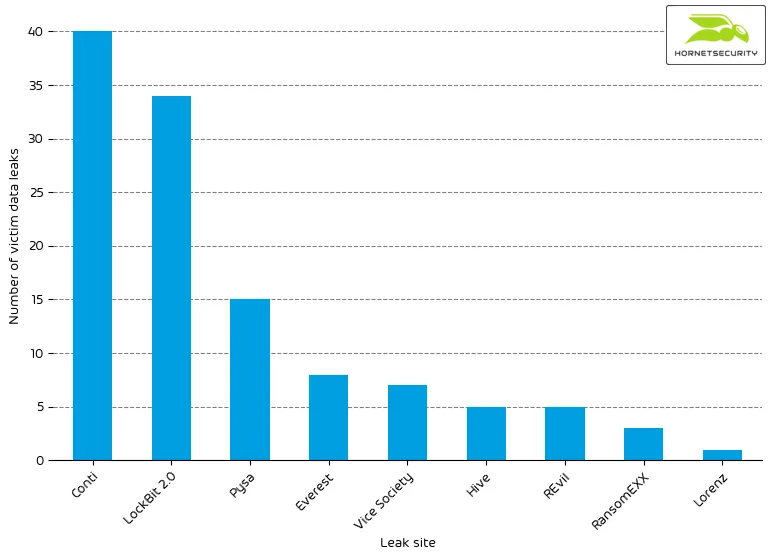
On 2021-09-16, an unnamed law enforcement agency obtained the decryption keys for the REvil ransomware and BitDefender released a decryptor.
On 2021-09-21, the Department of the Treasury’s Office of Foreign Assets Control’s (OFAC) added SUEX OTC, S.R.O. (SUEX), a virtual currency exchange, to its OFAC sanction list for its part in facilitating financial transactions for ransomware actors. Analysis of known SUEX transactions shows that over 40% of SUEX’s known transaction history is associated with illicit actors related to ransomware.2
This month LockBit 2.0 added a DDOS protection CAPTCHA to their site.
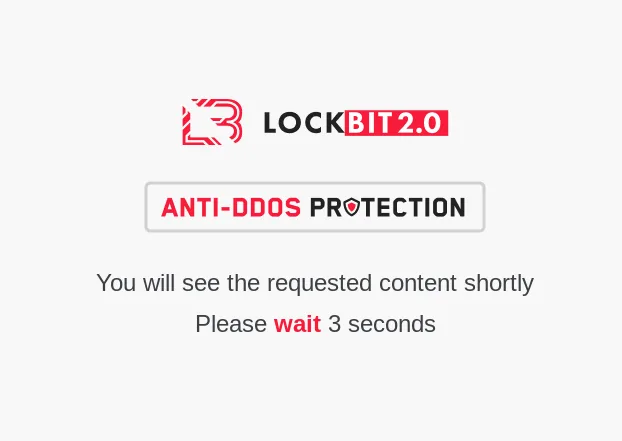
Cl0p ransomware has also added a CAPTCHA to their leak site, preventing automatic monitoring of announcements.
